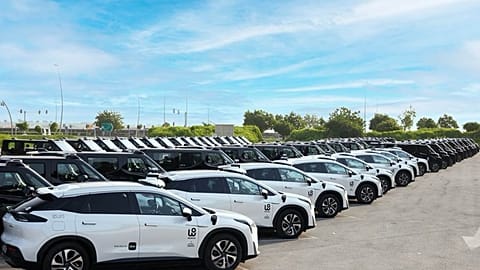It's 2100. Autonomous pods take you from home to the terminal and beyond, and biometrics allow smooth access to net-zero airports and aircraft.
What will travelling through the airports be like in the year 2100?
Slovenian architect Dušan Sekulić asked himself the same question. In 2022, he won second prize at the Fentress Global Challenge, an annual international architectural competition envisioning the airport experience of the future.
Reimagining the design of the world’s busiest airport, Hartsfield-Jackson International Airport in Atlanta, the United States, Sekulić turned it into a "drive-in airport" where airport visitors will use fully autonomous pods to glide seamlessly from their homes and on to their destination.
They will then hang onto a "flying crown" to fly to your destination. For longer distances, the pods can be loaded onto special aircraft to fly in a "swarm".
“You could have your whole home or your summer cottage inside of a pod and you move it together with the other swarms of pods in the flying wing constellation to your holiday destination. You could even have people that are living in the same neighbourhood that have a similar destination,” Sekulić told Euronews Next.
"So, in a way, the airport of the future is just the bridge between the land and the sky," he added.
Sekulić believes it is important to design future airports sustainably.
"So, this design is not only feasible but is actually also necessary. The future is exactly as we predict it. We have to predict it green and we have to predict it how we would like it. And this is the idea of futurism as I see it," Sekulić said.
Some of his design features may not be too far from reality.
Check in and pass security from your autonomous car
In the present day, the number of air travellers is on the rise, and rethinking airport design is necessary, experts say.
"The biggest challenge at the moment is the pace of growth of demand in the aviation industry," Robert Feteanu, International aviation director at HDR Inc., a US-based global design and engineering company, told Euronews Next.
"More people want to travel and the aging infrastructure. The forecast is that in 25 years we will double the demand for navigation, for the ability to travel, which means that in theory, if we continue doing business as usual, we should double our infrastructure, which is not possible".
Last year, HDR Inc. presented concepts to illustrate some of the possible benefits of autonomous technology for airports.
Among them was the idea that passengers could check-in and undergo initial security screening during the ride in a driverless car arranged by an airline or an airport. The luggage is delivered to a separate distribution centre.
Upon arrival at the airport, passengers will go through a "dynamic screening process" on a moving walkaway equipped with facial recognition technology and advanced X-ray scanners. The travelers can freely converse or move during the entire process.
While it is futuristic sounding, the technology for airports to be like this is already available.
South Korea, for example, implemented a facial recognition system at Incheon Airport in July, letting the passengers skip the process of scanning boarding passes and passports.
According to the International Air Transport Association’s 2022 Global Passenger Survey, 88 per cent of passengers are satisfied with the overall biometric process, while 75 per cent of them are eager to use biometrics instead of passports or boarding passes.
However, concerns about data security remain as an issue.
"I find it easier to implement in more technology-friendly zones like Asia or the Middle East. So, you can always look at Incheon, Changi, or Dubai. They are kind of pioneering that area," said Feteanu.
"They try to do things differently because they have a tendency to build in advance, being proactive and implementing these things whereas more traditional economies like Western Europe or North America, go a little bit reactive".
Airports and aircraft becoming net-zero
Technology to make airports more sustainable is also being tested and deployed.
Sweden’s state-owned airport operator Swedavia, a pioneer in sustainable air travel in Europe, is now aiming at making all domestic flights fossil-free by 2030 and all flights in Sweden by 2045.
The plan is to use electrical aircraft for shorter distances and hydrogen aircraft for longer distances, such as journeys within the EU.
For long hauls, sustainable aviation fuel (SAF) is being considered which Swedavia plans to eventually produce from forest residues in Sweden.
The state-owned company has recently announced a project for developing and testing an all-electric 30-seat aircraft, the ES-30, developed by a Swedish startup Heart Aerospace, at Malmö Airport in summer 2023.
It says the full-scale model aircraft will be tested and used to demonstrate taxiing and charging at the airport.
"If you take into account that all of those things are in place, I think aviation or flying should be the most sustainable way to travel in the future because you don't really need so much infrastructure," Lena Wennberg, Swedavia’s Sustainability and Environmental Manager, told Euronews Next.
From firefighting brigades and lawnmowers to intra-airport buses, Swedavia’s own operations are fossil-free and its airports have already achieved carbon neutrality in 2020, becoming the first operator in Europe to hit net-zero by cutting from 10,000 tonnes of carbon dioxide annually as of 2011.
"We have continuously reduced our emissions. It's really zero. It is not compensation or that sort of thing. We don't buy any credits," said Wennberg.
While the company operates at net-zero, not all partners working at Swedavia’s airports, however, are fossil-free just yet.
It is something Swedavia is currently working on, with hopes that the entire airport and all the companies and other organisations that operate there become fossil-free by 2030, in conjunction with the Swedish government’s Fossil-Free Sweden initiative.
Swedavia hopes to become a role model internationally and share its knowledge in sustainability through close cooperation with airports in Europe and around the world.
In 2019, 200 airports in 45 European countries pledged to all be fossil-free by 2050.
"We work very closely with European airports… This autumn, we are starting a collaboration with [among others] Hamburg Airport to improve hydrogen usage at airports. And a lot of the Baltics airports [are also included in that program]. So, we try to exchange ideas and experiences between all the airports in this field," said Wennberg.
"We have every kind of machine and tools or vehicles that are common in society. So if we can become zero emitters, everyone can. It's not so difficult. And it's not so expensive either," she added.
For more on this story, watch the video in the media player above.


















